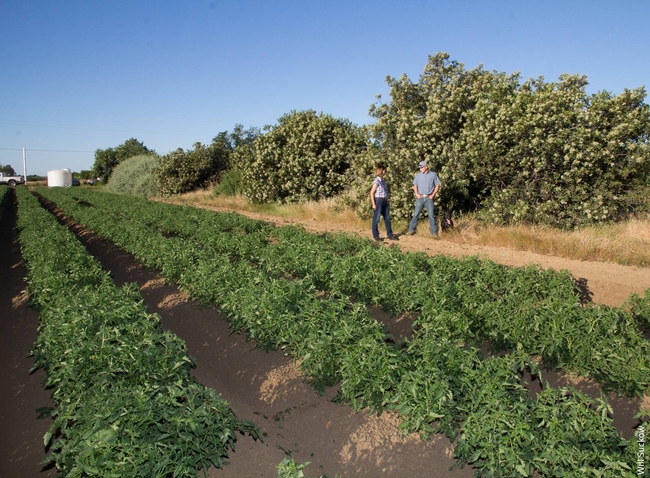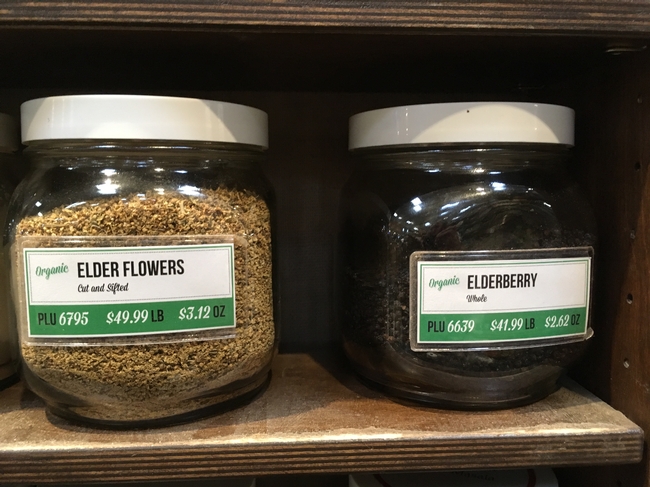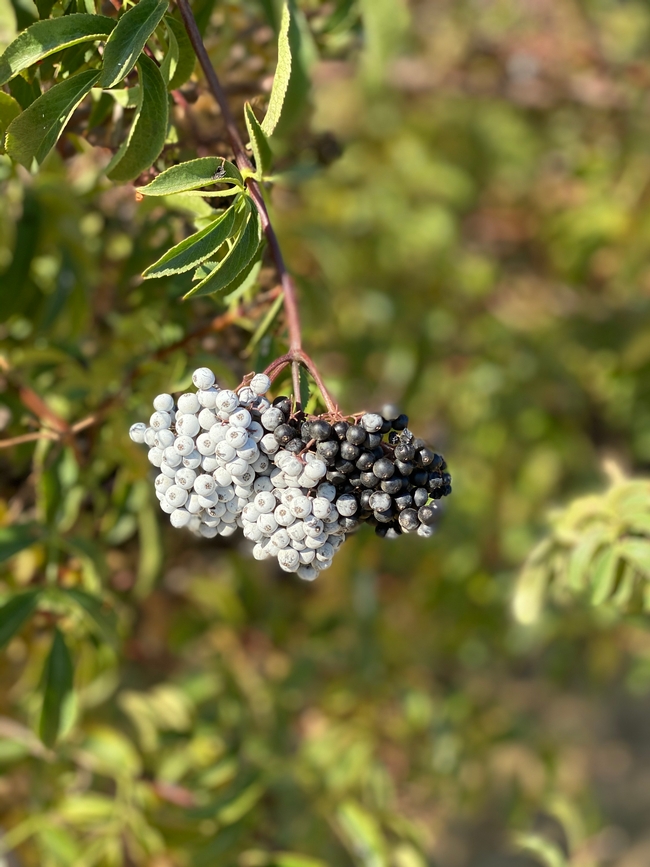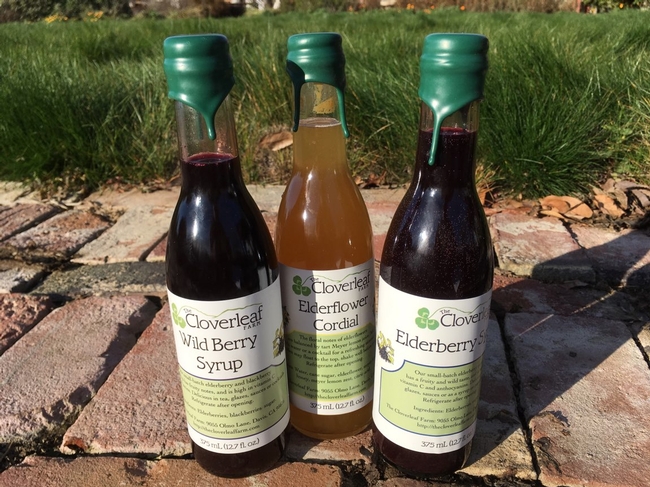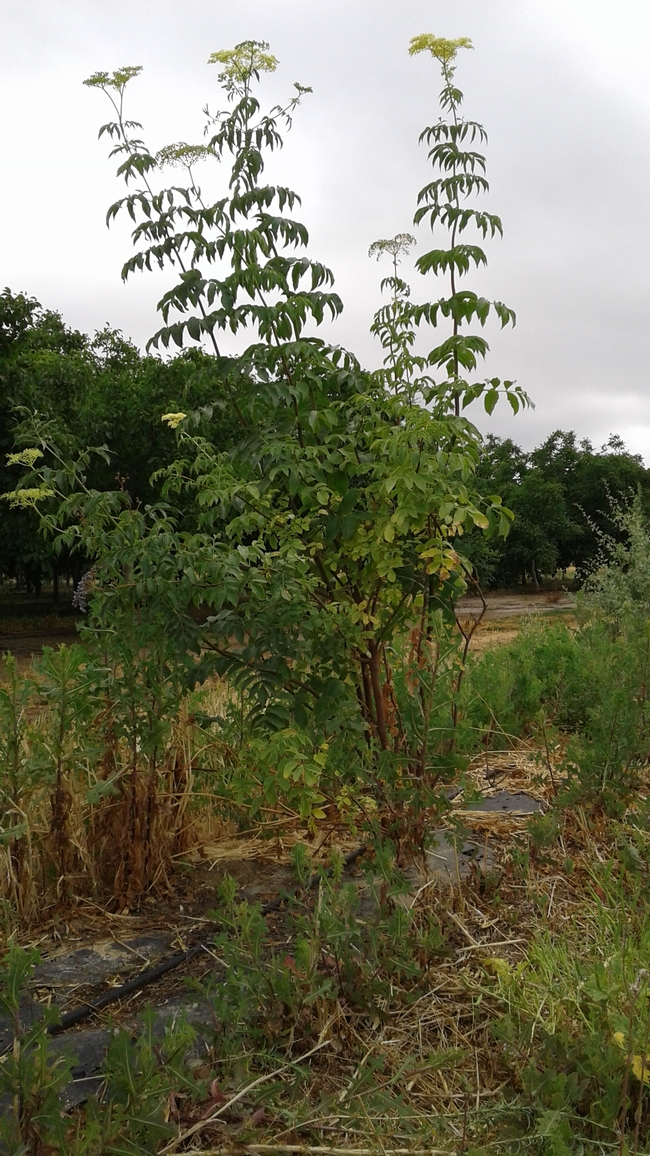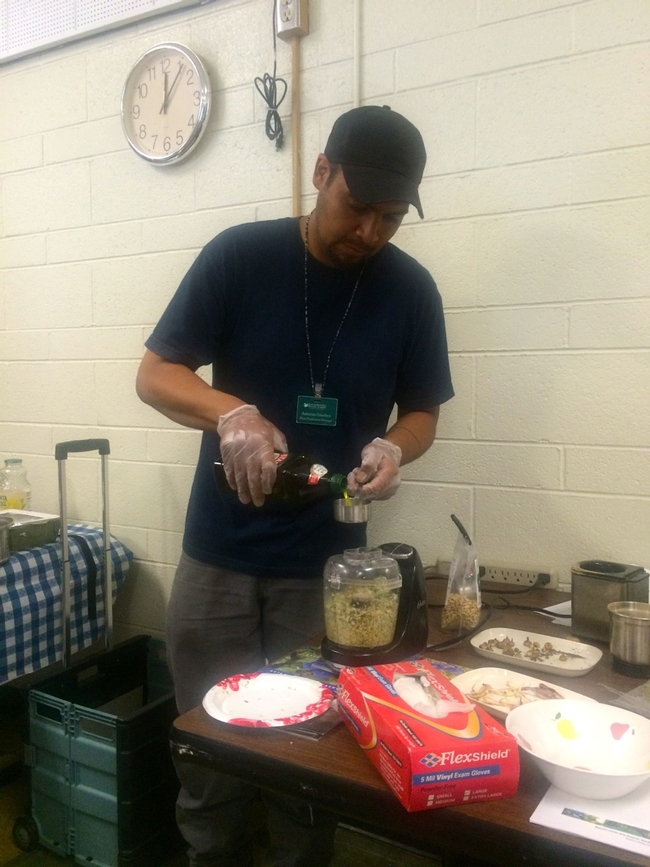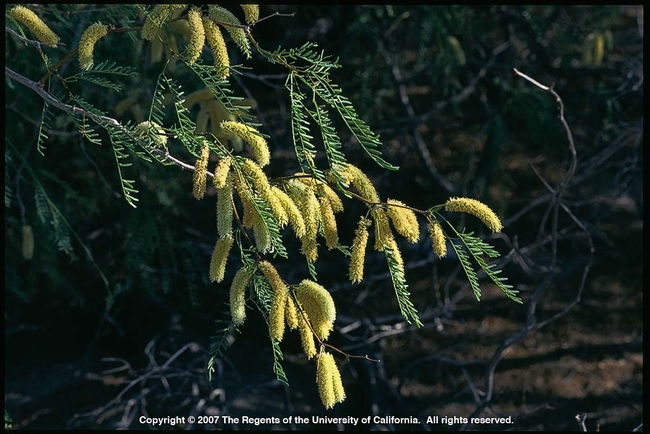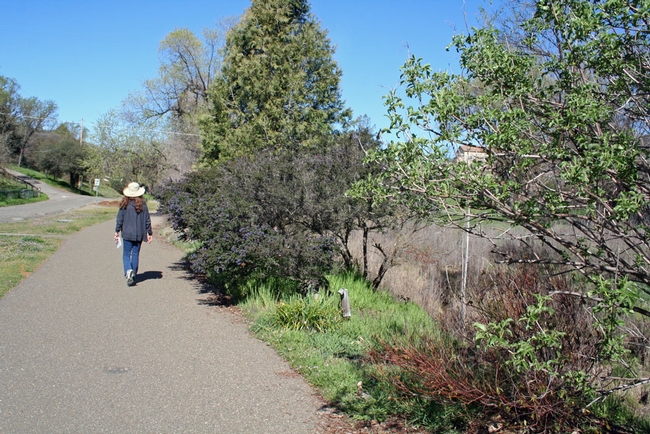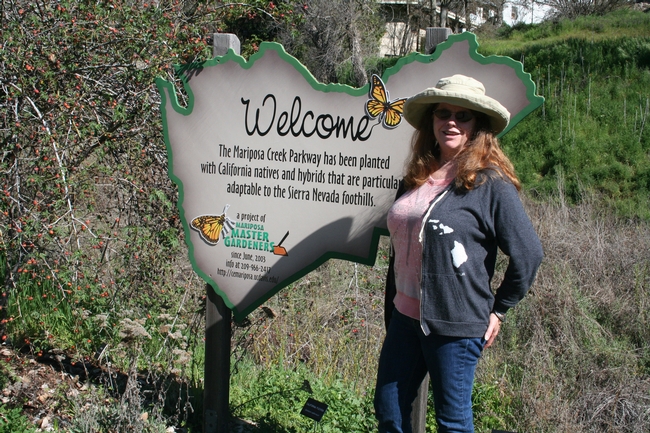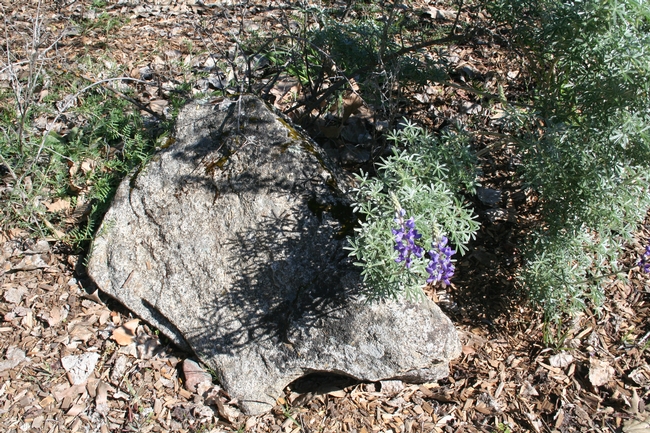Posts Tagged: native plants
Growing elderberries in hedgerows adds to farm income, benefits environment
As the sustainability of agriculture continues to be threatened by changes in climate, pests and loss of biodiversity, the ancient practice of planting hedgerows with edible and medicinal species such as elderberry can help growers generate additional revenue while fostering beneficial insects and improving soil health.
Most modern-day farmland is occupied by simple “monocrop” systems that often require frequent, energy-intensive inputs like synthetic fertilizers and pesticides to sustain their yields. These practices can be harmful to water quality, biodiversity and soil health.
But farmers who incorporate perennials into their farm landscapes can better harness living things—crop plants, pollinators, beneficial microbes and natural enemies of pests—to provide services rather than adding synthetic products, to the ultimate benefit of the farm and the environment.
Restoring field edges by planting hedgerows is a common way to add perennials to farm fields without taking land out of production. These managed rows of trees, shrubs, grasses and wildflowers were an ancient feature of agricultural landscapes throughout the world.
As farmland industrialized in Europe and North America in the 1900s, many old hedgerows were removed. But hedgerows have seen a resurgence in recent years as their significant environmental benefits—including natural pest control and pollination services, improved soil health and carbon sequestration—are increasingly recognized.
With hedgerows, “the whole farm can be a site of both conservation and profitability,” says Sonja Brodt, deputy director of the University of California Sustainable Agriculture Research & Education Program (UC SAREP).
Hedgerows can be costly to establish, and this is often the reason farmers choose not to use them. But incorporating a harvestable crop into a hedgerow can be profitable.
Brodt is leading a collaborative effort with California farmers and UC researchers to develop native western elderberry as a hedgerow cash crop. Blue elderberry (Sambucus nigra ssp. cerulea) is a native subspecies of elderberry that is well-adapted to Mediterranean climates and grows prolifically across California. It is thought to be more heat- and drought-tolerant than the more commercialized North American and European subspecies of elderberry.
“Elderberries have this great potential as a ‘win-win' crop. Farmers harvesting and selling elderberries from their hedgerows can receive a direct income from a farm practice that benefits the local ecosystem,” says Brodt.
Consumer demand for elderberry-based products has skyrocketed in recent years. Blue elderberry has similar antioxidant levels to blueberries and can be processed into products such as jams, syrups, tea mixtures and herbal supplements.
“We found that two-thirds of surveyed herbal and specialty foods processors and retailers were strongly interested in sourcing California-grown elderberries and couldn't find enough supply to meet their needs” says Gwenaël Engelskirchen of UC SAREP. Farmers who grow blue elderberry can tap into this growing market.
The research team recently completed a field trial in the southern Sacramento Valley to assess the profitability of blue elderberry. They found that elderberry yields from a 1,000-foot, multispecies hedgerow could provide $2,700 to $4,800 in revenue, after harvest and de-stemming costs, in only the second year after hedgerow planting. This revenue helps offset typical hedgerow establishment costs of $3,000 to $4,000, and elderberry revenue is expected to grow over time as the plant yields continue to increase. Value-added processing and specialty products made on-farm could also increase overall profitability.
While native elderberry hedgerows is a new area of research for the University of California, North America's indigenous people have been harvesting and tending blue elderberry in California for hundreds of years. Many Native persons across the state continue to gather, cultivate and use elderberry.
Sage LaPena, Nomtipom and Tunai Wintu ethnobotanist and certified medical herbalist, stresses that “elderberry is one of our most important traditional medicines and we've never stopped using it.” Cultivating elderberry for harvest could be one path towards increased food sovereignty for California's Native American tribes.
“There's an important lesson with this work,” said Brodt. “While new technologies are valuable for making agriculture more sustainable, we shouldn't lose sight of ancient practices that have benefited humanity and our landscapes over thousands of years. Hedgerows and other biological solutions are an essential piece of the sustainability puzzle. In addition, we have much to learn about the value of our native species from Native peoples and their traditional practices.”
To learn more about this research and to find educational resources for cultivating, processing, and marketing elderberry, visit https://ucanr.edu/sites/Elderberry.
New project seeks to build on the benefits of elderberries
Can plants typically grown for hedgerows also be a source of income? That's the question guiding a new UC study on the potential for farmers to grow elderberries as a commercial crop.
Blue elderberry, a California native plant with clusters of small bluish-black berries and a sweet-tart flavor, have long been eaten by Native Americans in the western states and are used today in jam, syrups, wines and liqueurs. And while elderberry orchards are popping up in parts of the Midwest, California's elderberries are usually just grown on field edges, and elderberry products sold retail rely mostly on foraged crops or imports.
Farmers at The Cloverleaf Farm near Davis are already selling elderberry products from plants grown on their farm, alongside their blackberries and stone fruits. And they find that customers love them. The farmers want to understand the viability of growing elderberries for market beyond their nascent effort, bringing some of the out-of-state production home.
The UC Sustainable Agriculture Research and Education Program (SAREP) launched a project in collaboration with the Cloverleaf Farm, the UC Agriculture Issues Center, UC Davis Department of Food Science and Technology, and four Central Valley farmers to assess the farm management practices, nutritional content, and market potential for elderberry and elderberry products in California.
“I think a lot about the long-term systems sustainability of our food system,” said Katie Fyhrie, one of the farmers at the Cloverleaf. “I keep thinking about how much we focus on production of blackberries and blueberries, when the elderberry also achieves that dark berry color and flavor people like with much fewer resources.”
Elderberries are typically grown on farms as hedgerows for their ability to attract beneficial insects, act as a windbreak, and sequester carbon, benefiting the overall health of the farm, but not providing direct benefit to a farmer's bottom line. Despite long-running federal cost-share programs for planting hedgerows, the number planted in California is still quite small relative to the large expanses of farmland in the state. Adding a financial incentive to planting elderberries may help increase the popularity of hedgerows amongst farmers.
“When we think about building sustainable farming practices, we can think about the whole farm as being a site of both conservation and profitability,” said Sonja Brodt, the project's principal researcher at UC SAREP. “Elderberries may have the potential to combine crop production with environmental conservation functions in a way not typically seen on California farms. This model would enable small- and medium-scale farmers to receive a direct income from a farm practice that benefits the ecosystem as well.”
As climate change impacts California with heat and unpredictable water availability, some studies suggest farmers may need to consider diversifying the crops they grow to adapt to changing local climates.
Elderberries, which grow in arid California regions along the coast and into the mountains, have the potential to grow in a range of climates and adapt to changing California ecosystems in the future.
It is unlikely that farmers would plant entire orchards of elderberries, in part because of restrictions on pruning elderberries that may be home to the Valley elderberry longhorn beetle, a federally threatened species. But for small- and medium-scale growers looking to diversify their income sources, elderberries may provide a boost.
The two-year elderberry project now underway will conclude with a growers' production guide, cost of production study, an assessment of market demand and nutritional contents, and workshops to help link growers with buyers interested in elderberry products. The project will also address issues related to the Valley elderberry longhorn beetle and generating income from hedgerows.
“Elderberry juice is already in so many products,” Fyrhie said, “so building a market for locally grown elderberries seems like a no-lose situation.”
For farmers interested in learning more about incorporating perennials into annual crop farms and similar agroforestry practices, view a webinar on the topic recently hosted by UC SAREP here.
Will edible native plants be a new food trend?
Will edible natives plants be a new food trend, the ultimate in eating locally? Antonio Sanchez at the Rancho Santa Ana Botanic Garden in Claremont hopes so. Among California native plants are many overlooked food sources, some with gourmet potential, according to Sanchez, production manager at the garden. As an added bonus, edible natives are often low-water users that look great in landscapes. He recently gave UC Master Gardeners in Los Angeles County an overview of edible natives, and had them taste some of his favorites, including his recipe for Cleveland Sage Pesto.
There are six native plants that Sanchez thinks are especially worth checking out.
- Miner's lettuce (Claytonia perfoliata). It's easy to grow and found throughout much of California. Its leaves can be used in salad, soup, or pesto. (It can also be a weed in certain situations, according to UC IPM).
- Cleveland sage (Salvia clevelandii). A beautiful, drought tolerant ornamental, it can also be used in pesto, beer, ice cream and baked goods.
- One-leaf onion (Allium unifolium). All parts of this native onion are edible.
- Honey mesquite (Prosopis glandulosa var. torreyana). Dried pods can be ground to make a gluten-free flour.
- Roger's California grape (Vitis ‘Roger's Red'). This plant, which was recently determined to be a hybrid between a native California grape and a cultivated grape, produces small, sweet fruit with seeds that can be eaten fresh, or used for juice or jelly.
- Golden currant (Ribes aureum). Fruit can be eaten fresh or made into jelly.
Adventurous cooks, gardeners, foragers, and anyone else who want to learn about edible native plants can attend the upcoming California Native Food Symposium, which will be held on November 14and 15 at the Rancho Santa Ana Botanic Garden.
The author is Rachel Surls, sustainable food systems advisor for UC Agriculture and Natural Resources Cooperative Extension in Los Angeles County.
Take a short jaunt in Mariposa to see a treasure of California native plants
A half-block from the highway that brings thousands of tourists to Yosemite National Park each year, the UC Agriculture and Natural Resources (UC ANR) Master Gardeners landscaped a short and scenic hiking path that provides the perfect break on a long drive.
The quarter-mile-long Mariposa Creek Parkway runs parallel to State Route 140 (Main Street in downtown Mariposa) on Stroming Road between Eighth and Sixth streets. Along the path, the Master Gardeners created the California Native Plant Demonstration Garden, which includes dozens of beautiful, drought-tolerant plants labeled for easy identification.
The path, which follows a short stretch of Mariposa Creek, was designed to increase appreciation for native flora and encourage Californians to consider “going native” in their own landscapes, said Kris Randal, coordinator of the Master Gardener program for UC ANR Cooperative Extension in Mariposa and Merced counties. Water shortages associated with the ongoing California drought are also driving interest in landscaping with native plants.
“Many natives are drought-tolerant, adapted to local soils, and rarely need fertilizers or pesticide treatments,” Randal said. “With some care and irrigation to get them started, they create a beautiful natural setting that brings pollinators and wildlife into your backyard.”
Randal was an advocate for native plants even before joining UC ANR. As a community educator for the Resource Conservation District in Mariposa County, she coordinated the transformation of a weedy parking lot around the district's building on the Mariposa Fairgrounds into a beautiful display of plants and wildflowers that occur naturally in the surroundings.
She did the same thing in her own Mariposa yard, bringing in and nursing the plants that flourish in natural areas.
“After I planted native brush and wildflowers, it was a joy for me to watch diversity come into my yard. Plant it, and they will come,” Randal said.
Randal suggests growing California native plants, even over native plants from other parts of the world with Mediterranean climates – such as Australia, Chile and South Africa – which also are often recommended because of their low water needs.
The California natives, she said, support local wildlife and pollinators, have historical and cultural importance, and save time and expense while adding beauty and ecological health to the environment. Native plants attract native bees, butterflies and hummingbirds and provide seeds, nuts and fruits for other native birds and wildlife. Native plants promote soil health by supporting flora and fauna that flourish underground.
“There's all kinds of magic going on under the soil,” Randal said.
As a first step toward converting to native landscaping, Randal suggests finding a natural area close to home and visiting it every few weeks to see what is growing, and what is blooming. Take notes and consult a plant guide or the Internet to identify the plants.
“It sounds like a lot of work, but it's not,” Randal said. “It's fun.”
This task is particularly convenient for Mariposa County residents, where the UC ANR Master Gardeners planted a wide array of beautiful native plants in one place.
Under the auspices of UC ANR Cooperative Extension, Master Gardeners are trained by UC ANR academics in research-based and sustainable gardening and landscaping practices. They become volunteer educators for non-commercial gardeners. In Mariposa County, a significant amount of volunteer time goes into tending the native plant garden.
In early spring, one of the first deciduous shrubs to leaf-out on the pathway is California buckeye. The leathery, pear-shaped fruits contain seeds that are easily sprouted, or they can be used in dried flower arrangements.
Along the trail, visitors will find California fuchsia, known by many as a natural hummingbird feeder. Blue elderberry, columbine and manzanita also attract hummingbirds to the demonstration garden.
Randal points out soap root, which looks like a grouping of long spindly leaves growing from the ground. Native Americans used pulp from the bulb to make a soapy lather, and they used the fibrous and hairy husks of the bulb to make small brushes to whisk out acorn shell debris from grinding holes.
One of Randal's favorite natives, she said, is a low creeping sage. The fragrant plant forms a low mat as big as 10 feet across with blue-violet flowers May to June. “This is great in a pine forest where it will get afternoon shade,” Randal said.
A lovely shrub known as Ceanothus blue jeans produces profuse powder-blue clustered flowers. The tall evergreen provides a colorful show of flowers with no care or irrigation. Western redbud explodes with magenta blossoms in the spring. Native Americans used the branches for basket weaving and made a red dye from the bark. Red Twig dogwood produces beautiful white blooms in early summer, and its bright red branches are a unique display in the winter.
“Growing native plants help you appreciate your surroundings and feel more connected to the natural world,” Randal said. “It attracts more life and that's why many of us garden.”
An initiative to maintain and enhance healthy families and communities is part of the UC Division of Agriculture and Natural Resources Strategic Vision 2025.
Author: Jeannette Warnert
Native plants offer myriad rural benefits
The economic benefits of dedicating some farmland to grow native plants are not well understood. But for Winters farmer John Anderson, the question is less one of dollars and more one of sense, according to an article in the Vacaville Reporter.
As part of a Food Systems and Sustainability Symposium held at the UC Davis Agricultural Sustainability Institute recently, participants toured Anderson's Hedgerow Farms, where he produces more than 60 native plant species on 400 acres.
Anderson said native plants attract beneficial bugs, reduce erosion, stop invasive weeds, boost crop yields through native bee pollination and add a scenic touch to otherwise barren edges of farmland, writer Geoff Johnson reported.
California's natural ecosystems have been severely impacted by farming and development. UC Cooperative Extension farm advisor Rachael Long said the state's biodiversity is likely to suffer even more as the state grows. California is expected to push past 50 million residents by 2032.
"There's tremendous pressure on our natural resources here," Long was quoted in the article. Because of the absence of economic incentives, Anderson said he believes the government should consider installing native plants. A location he pointed out to tour participants is 17,000 miles of irrigation canal banks in California's Central Valley. Adding native hedge rows to just five percent of that could make a dramatic difference, he said.
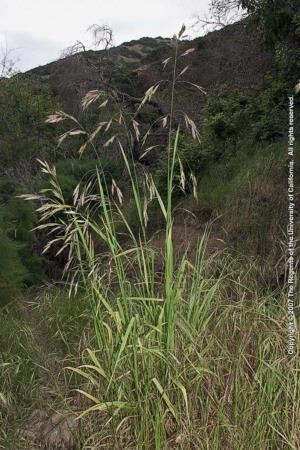
California brome.

